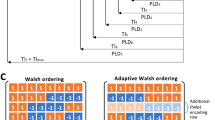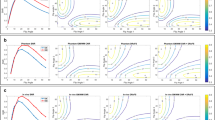Abstract
Object
In pulsed arterial spin labelling (ASL), Q2TIPS saturation pulses are used to actively control the temporal width of the labelled bolus. However, these Q2TIPS pulses also induce magnetisation transfer (MT) effects in the adjacent tissue. In this work, we investigated how Q2TIPS-related MT alters tissue signal in pulsed ASL and, consequently, CBF quantification.
Materials and methods
Seven volunteers were studied at 3 tesla using a multi-TI FAIR sequence and 3D-GRASE readout with background suppression. Q2TIPS pulses were used and the spacing between RF pulses was varied to modulate MT effects. Computer simulations were designed to mimic in-vivo signals at multiple TI values.
Results
Q2TIPS-associated MT was found to reduce tissue T1 and M0 values by up to 42 and 50% respectively; leading to a reduction of up to 40% in the effectiveness of background suppression and, therefore, increased sensitivity to motion for the longest TI values. In addition, greater MT effects were associated with reduced grey matter CBF estimates of up to 15%.
Conclusions
The MT effect associated with the Q2TIPS pulse train has a significant effect on tissue signal. It is recommended that MT effects are characterised and both background suppression and Q2TIPS schemes are accordingly optimised to reduce the effects of MT on accuracy and precision of CBF estimation.








Similar content being viewed by others

References
Petersen ET, Mouridsen K, Golay X, all named co-authors of the QUASAR test-retest study (2010) The QUASAR reproducibility study, Part II: results from a multi-center Arterial Spin Labeling test-retest study. Neuroimage 49(1):104–113
Wong EC, Buxton RB, Frank LR (1998) Quantitative imaging of perfusion using a single subtraction (QUIPSS and QUIPSS II). Magn Reson Med 39(5):702–708
Luh WM, Wong EC, Bandettini PA, Hyde JS (1999) QUIPSS II with thin-slice TI1 periodic saturation: a method for improving accuracy of quantitative perfusion imaging using pulsed arterial spin labeling. Magn Reson Med 41(6):1246–1254
Günther M, Bock M, Schad LR (2001) Arterial spin labeling in combination with a look-locker sampling strategy: inflow turbo-sampling EPI-FAIR (ITS-FAIR). Magn Reson Med 46(5):974–984
Petersen ET, Lim T, Golay X (2006) Model-free arterial spin labeling quantification approach for perfusion MRI. Magn Reson Med 55(2):219–232
MacIntosh BJ, Filippini N, Chappell MA, Woolrich MW, Mackay CE, Jezzard P (2010) Assessment of arterial arrival times derived from multiple inversion time pulsed arterial spin labeling MRI. Magn Reson Med 63(3):641–647
Buxton RB, Frank LR, Wong EC, Siewert B, Warach S, Edelman RR (1998) A general kinetic model for quantitative perfusion imaging with arterial spin labeling. Magn Reson Med 40(3):383–396
MacIntosh BJ, Pattinson KT, Gallichan D, Ahmad I, Miller KL, Feinberg DA, Wise RG, Jezzard P (2008) Measuring the effects of remifentanil on cerebral blood flow and arterial arrival time using 3D GRASE MRI with pulsed arterial spin labelling. J Cereb Blood Flow Metab 28(8):1514–1522
Ye FQ, Frank JA, Weinberger DR, McLaughlin AC (2000) Noise reduction in 3D perfusion imaging by attenuating the static signal in arterial spin tagging (ASSIST). Magn Reson Med 44(1):92–100
Wong EC, Buxton RB, Frank LR (1998) A theoretical and experimental comparison of continuous and pulsed arterial spin labeling techniques for quantitative perfusion imaging. Magn Reson Med 40(3):348–355
Golay X, Hendrikse J, Lim TC (2004) Perfusion imaging using arterial spin labeling. Top Magn Reson Imaging 15(1):10–27
Kim SG (1995) Quantification of relative cerebral blood flow change by flow-sensitive alternating inversion recovery (FAIR) technique: application to functional mapping. Magn Reson Med 34(3):293–301
Kwong KK, Belliveau JW, Chesler DA, Goldberg IE, Weisskoff RM, Poncelet BP, Kennedy DN, Hoppel BE, Cohen MS, Turner R et al (1992) Dynamic magnetic resonance imaging of human brain activity during primary sensory stimulation. Proc Natl Acad Sci USA 89(12):5675–5679
Günther M, Oshio K, Feinberg DA (2005) Single-shot 3D imaging techniques improve arterial spin labeling perfusion measurements. Magn Reson Med 54(2):491–498
Griswold MA, Jakob PM, Heidemann RM, Nittka M, Jellus V, Wang J, Kiefer B, Haase A (2002) Generalized autocalibrating partially parallel acquisitions (GRAPPA). Magn Reson Med 47:1202–1210
Golay X, Petersen ET, Hui F (2005) Pulsed star labeling of arterial regions (PULSAR): a robust regional perfusion technique for high field imaging. Magn Reson Med 53(1):15–21
Ordidge RJ, Wylezinska M, Hugg JW, Butterworth E, Franconi F (1996) Frequency offset corrected inversion (FOCI) pulses for use in localized spectroscopy. Magn Reson Med 36(4):562–566
Lu H, Nagae-Poetscher LM, Golay X, Lin D, Pomper M, van Zijl PC (2005) Routine clinical brain MRI sequences for use at 3.0 Tesla. J Magn Reson Imaging 22(1):13–22
Wong EC, Buxton RB, Frank LR (1997) Implementation of quantitative perfusion imaging techniques for functional brain mapping using pulsed arterial spin labeling. NMR Biomed 10(4–5):237–249
Chappell MA, Groves AR, Whitcher B, Woolrich MW (2009) Variational Bayesian inference for a non-linear forward model. IEEE Trans Signal Process 57(1):223–236
Gallichan D, Jezzard P (2009) Variation in the shape of pulsed arterial spin labeling kinetic curves across the healthy human brain and its implications for CBF quantification. Magn Reson Med 61(3):686–695
Hernandez-Garcia L, Lewis DP, Moffat B, Branch CA (2007) Magnetization transfer effects on the efficiency of flow-driven adiabatic fast passage inversion of arterial blood. NMR Biomed 20(8):733–742
Pike GB, Hu BS, Glover GH, Enzmann DR (1992) Magnetization transfer time-of-flight magnetic resonance angiography. Magn Reson Med 25(2):372–379
Thomas DL, Lythgoe MF, Gadian DG, Ordidge RJ (2006) In vivo measurement of the longitudinal relaxation time of arterial blood (T1a) in the mouse using a pulsed arterial spin labeling approach. Magn Reson Med 55(4):943–947
Varela M, Hajnal JV, Petersen ET, Golay X, Merchant N, Larkman DJ (2011) A method for rapid in vivo measurement of blood T1. NMR Biomed 24(1):80–88
Acknowledgments
The authors thank all the volunteers that gave their time for this project. Special thanks to Dr Michael Chappell from the FMRIB in Oxford for providing the authors with a version of FSL-BASIL before its public release, with documentation on its use. We also thank the paper reviewers for their useful comments and suggestions. This work was undertaken at University College London Hospitals/University College London, which received a proportion of funding from the Department of Health’s National Institute for Health Research Comprehensive Biomedical Research Centre funding scheme. The Collaboration between M.G and UCL was facilitated by European COST Action BM1103 on “Arterial spin labelling Initiative in Dementia (AID)”. M.G. was in part funded by the German Ministry of Education and Research (BMBF) under grant number 01EV0702.
Author information
Authors and Affiliations
Corresponding author
Rights and permissions
About this article
Cite this article
De Vita, E., Günther, M., Golay, X. et al. Magnetisation transfer effects of Q2TIPS pulses in ASL. Magn Reson Mater Phy 25, 113–126 (2012). https://doi.org/10.1007/s10334-011-0298-z
Received:
Revised:
Accepted:
Published:
Issue Date:
DOI: https://doi.org/10.1007/s10334-011-0298-z



